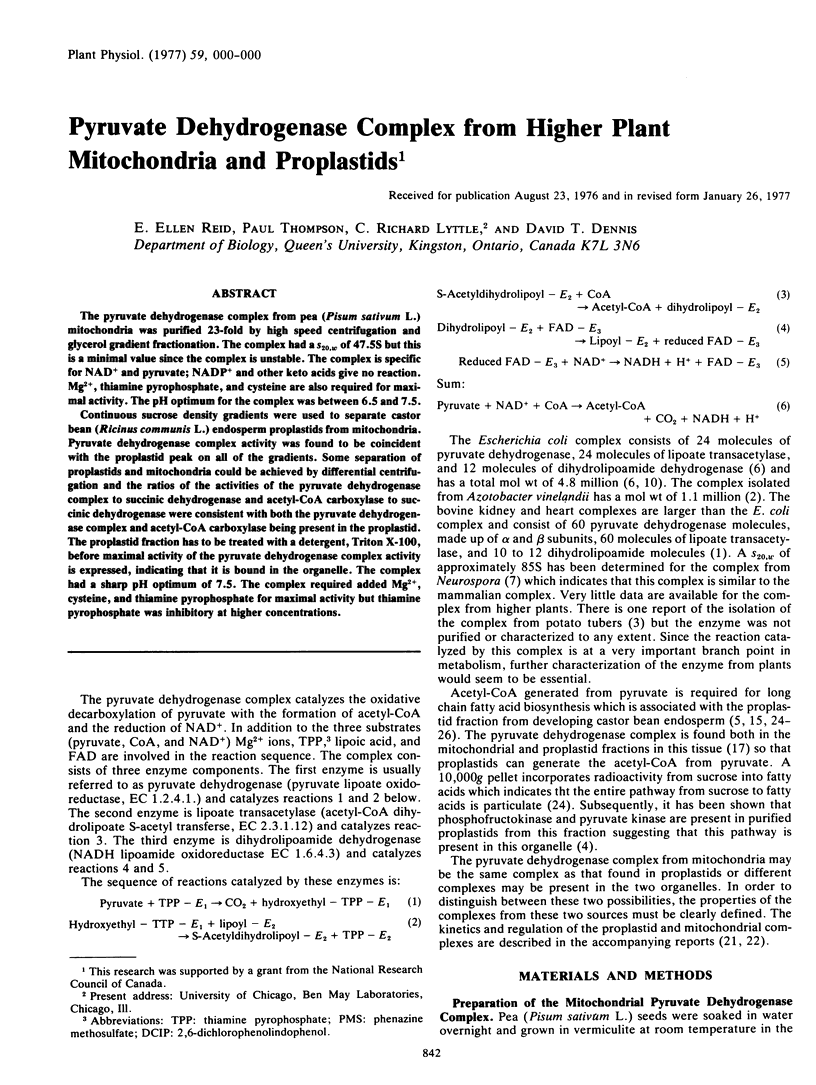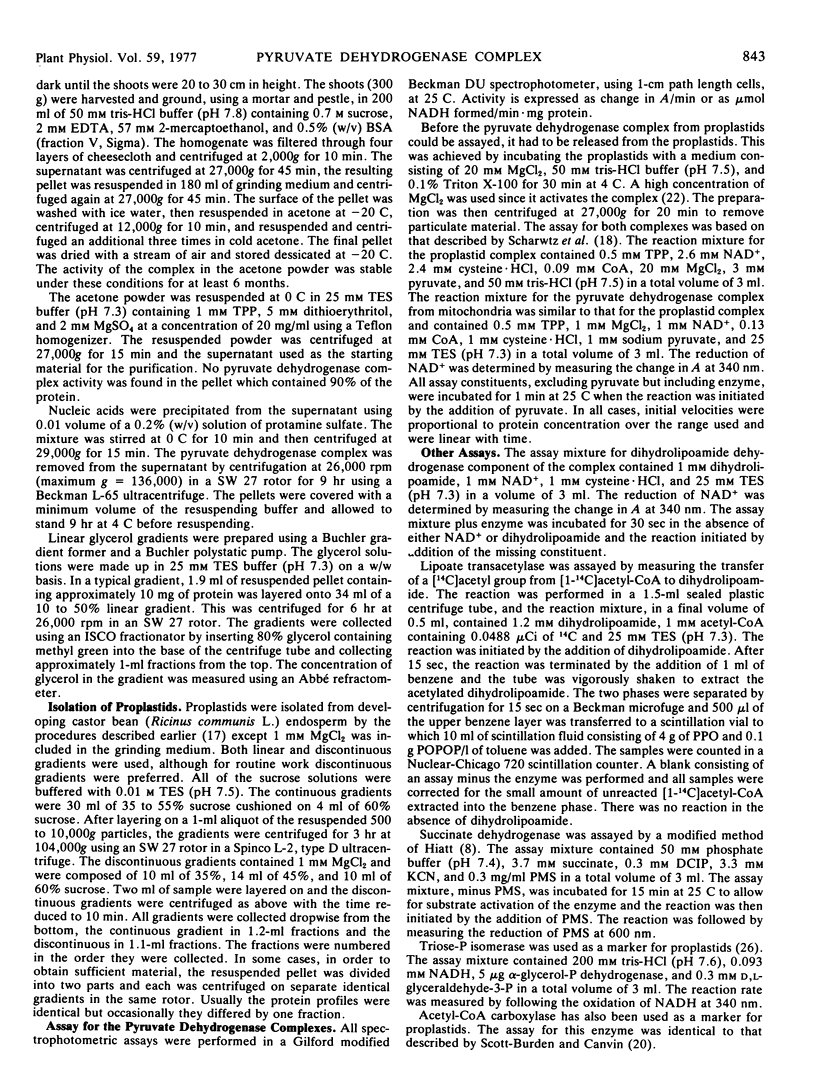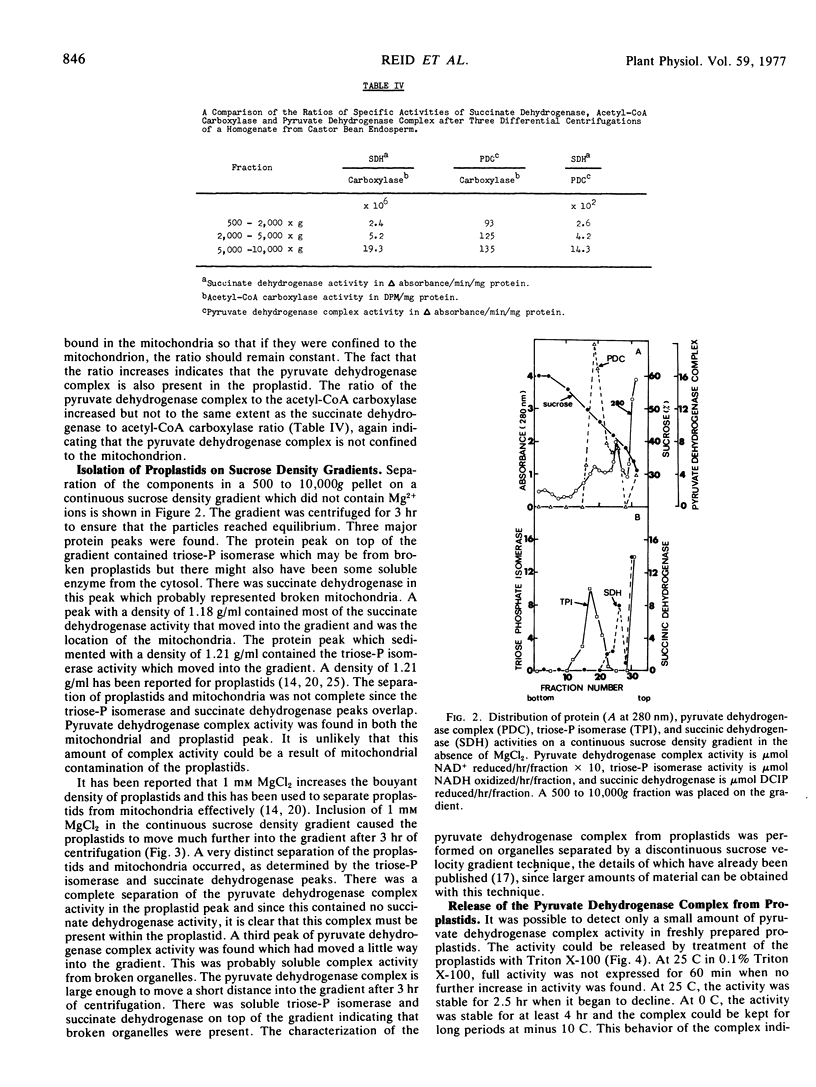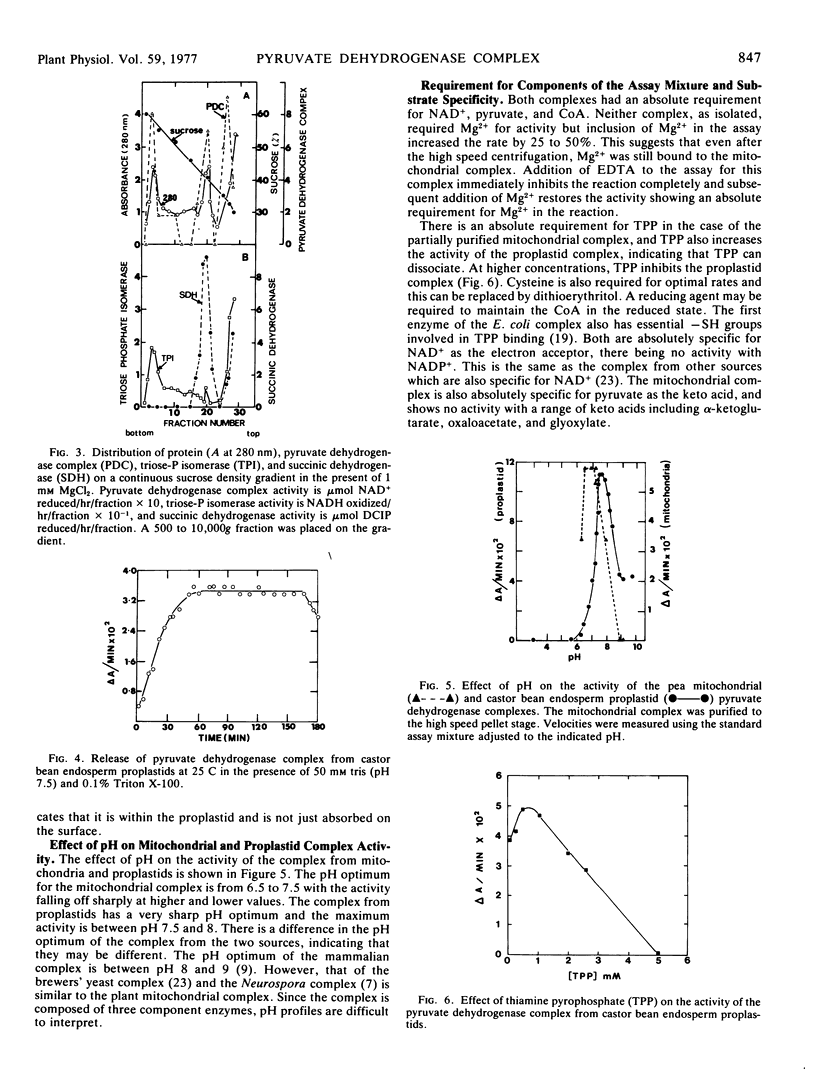Abstract
The pyruvate dehydrogenase complex from pea (Pisum sativum L.) mitochondria was purified 23-fold by high speed centrifugation and glycerol gradient fractionation. The complex had a s20,w of 47.5S but this is a minimal value since the complex is unstable. The complex is specific for NAD+ and pyruvate; NADP+ and other keto acids give no reaction. Mg2+, thiamine pyrophosphate, and cysteine are also required for maximal activity. The pH optimum for the complex was between 6.5 and 7.5.
Continuous sucrose density gradients were used to separate castor bean (Ricinus communis L.) endosperm proplastids from mitochondria. Pyruvate dehydrogenase complex activity was found to be coincident with the proplastid peak on all of the gradients. Some separation of proplastids and mitochondria could be achieved by differential centrifugation and the ratios of the activities of the pyruvate dehydrogenase complex to succinic dehydrogenase and acetyl-CoA carboxylase to succinic dehydrogenase were consistent with both the pyruvate dehydrogenase complex and acetyl-CoA carboxylase being present in the proplastid. The proplastid fraction has to be treated with a detergent, Triton X-100, before maximal activity of the pyruvate dehydrogenase complex activity is expressed, indicating that it is bound in the organelle. The complex had a sharp pH optimum of 7.5. The complex required added Mg2+, cysteine, and thiamine pyrophosphate for maximal activity but thiamine pyrophosphate was inhibitory at higher concentrations.
Full text
PDF






Selected References
These references are in PubMed. This may not be the complete list of references from this article.
- Barrera C. R., Namihira G., Hamilton L., Munk P., Eley M. H., Linn T. C., Reed L. J. -Keto acid dehydrogenase complexes. XVI. Studies on the subunit structure of the pyruvate dehydrogenase complexes from bovine kidney and heart. Arch Biochem Biophys. 1972 Feb;148(2):343–358. doi: 10.1016/0003-9861(72)90152-x. [DOI] [PubMed] [Google Scholar]
- Bresters T. W., de Abreu R. A., de Kok A., Visser J., Veeger C. The pyruvate-dehydrogenase complex from Azotobacter vinelandii. Eur J Biochem. 1975 Nov 15;59(2):335–345. doi: 10.1111/j.1432-1033.1975.tb02460.x. [DOI] [PubMed] [Google Scholar]
- Crompton M., Laties G. G. The regulatory function of potato pyruvate dehydrogenase. Arch Biochem Biophys. 1971 Mar;143(1):143–150. doi: 10.1016/0003-9861(71)90194-9. [DOI] [PubMed] [Google Scholar]
- Dennis D. T., Green T. R. Soluble and particulate glycolysis in developing castor bean endosperm. Biochem Biophys Res Commun. 1975 Jan 2;64(3):970–975. doi: 10.1016/0006-291x(75)90142-4. [DOI] [PubMed] [Google Scholar]
- Drennan C. H., Canvin D. T. Oleic acid synthesis by a particulate preparation from developing castor oil seeds. Biochim Biophys Acta. 1969;187(2):193–200. doi: 10.1016/0005-2760(69)90027-7. [DOI] [PubMed] [Google Scholar]
- Eley M. H., Namihira G., Hamilton L., Munk P., Reed L. J. -Keto acid dehydrogenase complexes. 18. Subunit composition of the Escherichia coli pyruvate dehydrogenase complex. Arch Biochem Biophys. 1972 Oct;152(2):655–669. doi: 10.1016/0003-9861(72)90262-7. [DOI] [PubMed] [Google Scholar]
- Harding R. W., Caroline D. F., Wagner R. P. The pyruvate dehydrogenase complex from the mitochondrial fraction of Neurospora crassa. Arch Biochem Biophys. 1970 Jun;138(2):653–661. doi: 10.1016/0003-9861(70)90393-0. [DOI] [PubMed] [Google Scholar]
- Hiatt A. J. Preparation & some properties of soluble succinic dehydrogenase from higher plants. Plant Physiol. 1961 Sep;36(5):552–557. doi: 10.1104/pp.36.5.552. [DOI] [PMC free article] [PubMed] [Google Scholar]
- KOIKE M., REED L. J., CARROLL W. R. alpha-Keto acid dehydrogenation complexes. I. Purification and properties of pyruvate and alpha-ketoglutarate dehydrogenation complexes of Escherichia coli. J Biol Chem. 1960 Jul;235:1924–1930. [PubMed] [Google Scholar]
- Kanzaki T., Hayakawa T., Hamada M., Fukuyoshi Y., Koike M. Mammalian alpha-keto acid dehydrogenase complexes. IV. Substrate specificities and kinetic properties of the pig heart pyruvate and 2-oxyoglutarate dehydrogenase complexes. J Biol Chem. 1969 Mar 10;244(5):1183–1187. [PubMed] [Google Scholar]
- LOWRY O. H., ROSEBROUGH N. J., FARR A. L., RANDALL R. J. Protein measurement with the Folin phenol reagent. J Biol Chem. 1951 Nov;193(1):265–275. [PubMed] [Google Scholar]
- LUSTY C. J., SINGER T. P. LIPOYL DEHYDROGENASE. FREE AND COMPLEXED FORMS IN MAMMALIAN MITOCHONDRIA. J Biol Chem. 1964 Nov;239:3733–3742. [PubMed] [Google Scholar]
- McEwen C. R. Tables for estimating sedimentation through linear concentration gradients of sucrose solution. Anal Biochem. 1967 Jul;20(1):114–149. doi: 10.1016/0003-2697(67)90271-0. [DOI] [PubMed] [Google Scholar]
- Miflin B. J., Beevers H. Isolation of intact plastids from a range of plant tissues. Plant Physiol. 1974 Jun;53(6):870–874. doi: 10.1104/pp.53.6.870. [DOI] [PMC free article] [PubMed] [Google Scholar]
- REED L. J., KOIKE M., LEVITCH M. E., LEACH F. R. Studies on the nature and reactions of protein-bound lipoic acid. J Biol Chem. 1958 May;232(1):143–158. [PubMed] [Google Scholar]
- Reid E. E., Lyttle C. R., Canvin D. T., Dennis D. T. Pyruvate dehydrogenase complex activity in proplastids and mitochondria of developing castor bean endosperm. Biochem Biophys Res Commun. 1975 Jan 6;62(1):42–47. doi: 10.1016/s0006-291x(75)80402-5. [DOI] [PubMed] [Google Scholar]
- Schwartz E. R., Old L. O., Reed L. J. Regulatory properties of pyruvate dehydrogenase from Escherichia coli. Biochem Biophys Res Commun. 1968 May 10;31(3):495–500. doi: 10.1016/0006-291x(68)90504-4. [DOI] [PubMed] [Google Scholar]
- Schwartz E. R., Reed L. J. Alpha-keto acid dehydrogenase complexes. 13. Reaction of sulfhydryl groups in pyruvate dehydrogenase with organic mercurials. J Biol Chem. 1970 Jan 10;245(1):183–187. [PubMed] [Google Scholar]
- Thompson P., Reid E. E., Lyttle C. R., Dennis D. T. Pyruvate dehydrogenase complex from higher plant mitochondria and proplastids: kinetics. Plant Physiol. 1977 May;59(5):849–853. doi: 10.1104/pp.59.5.849. [DOI] [PMC free article] [PubMed] [Google Scholar]
- Thompson P., Reid E. E., Lyttle C. R., Dennis D. T. Pyruvate dehydrogenase complex from higher plant mitochondria and proplastids: regulation. Plant Physiol. 1977 May;59(5):854–858. doi: 10.1104/pp.59.5.854. [DOI] [PMC free article] [PubMed] [Google Scholar]
- Wais U., Gillmann U., Ullrich J. Isolation and characterisation of pyruvate dehydrogenase complex from brewer's yeast. Hoppe Seylers Z Physiol Chem. 1973 Oct-Nov;354(10-11):1378–1388. doi: 10.1515/bchm2.1973.354.2.1378. [DOI] [PubMed] [Google Scholar]
- Zilkey B., Canvin D. T. Subcellular localization of oleic acid biosynthesis enzymes in the developing castor bean endosperm. Biochem Biophys Res Commun. 1969 Mar 10;34(5):646–653. doi: 10.1016/0006-291x(69)90787-6. [DOI] [PubMed] [Google Scholar]


